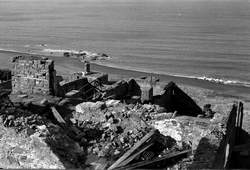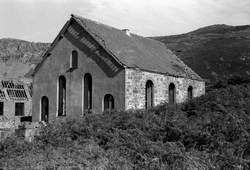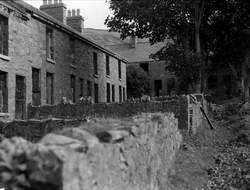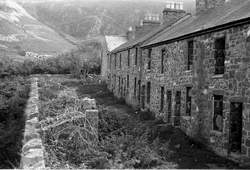Abandoned Communities ..... Porth y Nant
From time to time there were proposals that the track down to the village should be replaced with a proper road. The Daily Mirror took up the cause on 11 February, 1938, in an article with the title “Mountain-Track Village Wants Road to the World”. The article acknowledged that a road would cost £20,000, and it mentioned an alternative view that the villagers should be re-housed in Llithfaen. But in general it supported the building of a road, helping to bolster the case by including a photograph of a stretcher being carried up the Screw, on this occasion being held by six stretcher bearers and hauled by eleven others.
Caernarfonshire County Council arranged for an inspector and later an engineer to visit and make recommendations. Both came to a negative conclusion, and the road was never built.
Early in World War II the owners of Porth y Nant quarry, Amalgamated Roadstone Corporation, decided to close the quarry. In the circumstances of the war there may have been less demand for crushed stone, and in addition it appears that it was becoming increasingly difficult to book cargo ships small enough to use the jetty. Another quarry in the same bay as Porth y Nant, Carreg y Llam, continued in operation for another couple of decades, but it had the advantage of access to the railway network.
Some workers may have been redeployed at Carreg y Llam or may have found jobs at other quarries in the neighbourhood. They may have continued to live at Porth y Nant for some time, but before long nearly everyone had departed. When a reporter from the Herald of Wales visited the village in March 1954 there were just three residents, Mr William Owen and his sister Mrs Williams at No. 3 and Mr George Scott at No. 10. In addition there was a family with five children living in the farmhouse at Ty Canol. The postman still made daily deliveries and collected the mail from a box in a wall, and reluctant doctors were still obliged to make occasional visits to sick patients.
The article, accompanied by several excellent photographs, appeared in the Herald of Wales on 27 March, 1954.
In the 1960s and early 1970s houses in the village were sometimes occupied on an unofficial basis. At one stage several houses were used by a group of people intent on developing an alternative lifestyle. They have been blamed for most of the damage done to the houses at that time, in particular the removal of much of the wood for use as fuel.
By 1970 it was clear that the quarry would never open again. Amalgamated Roadstone Corporation invited proposals for the regeneration of the village. Options considered by ARC included an oil terminal and a holiday centre. But the proposal that appealed to them most was to convert the place into a centre for the Welsh language. The pioneer behind this concept was a local GP, Dr Carl Clowes, who created the Nant Gwrtheyrn Trust to develop detailed plans and co-ordinate fund raising.
Carl Clowes has written an account, in Welsh and in English, of the history of Nant Gwrtheyrn. The English version, Nant Gwrtheyrn: Rebirth of the Lost Village, was published by Ymddiriedolaeth Nant Gwrtheyrn in 2008.
Contracts were exchanged between the Trust and ARC at a ceremony in July 1978. At that time the Trust had raised £15,000, but had to make a commitment to raise a further £300,000 over the next five years. This commitment was eased slightly at the end of the ceremony when ARC’s Business Director, Mr Ken Ashton, handed over a cheque for £5000.
Caernarfonshire County Council arranged for an inspector and later an engineer to visit and make recommendations. Both came to a negative conclusion, and the road was never built.
Early in World War II the owners of Porth y Nant quarry, Amalgamated Roadstone Corporation, decided to close the quarry. In the circumstances of the war there may have been less demand for crushed stone, and in addition it appears that it was becoming increasingly difficult to book cargo ships small enough to use the jetty. Another quarry in the same bay as Porth y Nant, Carreg y Llam, continued in operation for another couple of decades, but it had the advantage of access to the railway network.
Some workers may have been redeployed at Carreg y Llam or may have found jobs at other quarries in the neighbourhood. They may have continued to live at Porth y Nant for some time, but before long nearly everyone had departed. When a reporter from the Herald of Wales visited the village in March 1954 there were just three residents, Mr William Owen and his sister Mrs Williams at No. 3 and Mr George Scott at No. 10. In addition there was a family with five children living in the farmhouse at Ty Canol. The postman still made daily deliveries and collected the mail from a box in a wall, and reluctant doctors were still obliged to make occasional visits to sick patients.
The article, accompanied by several excellent photographs, appeared in the Herald of Wales on 27 March, 1954.
In the 1960s and early 1970s houses in the village were sometimes occupied on an unofficial basis. At one stage several houses were used by a group of people intent on developing an alternative lifestyle. They have been blamed for most of the damage done to the houses at that time, in particular the removal of much of the wood for use as fuel.
By 1970 it was clear that the quarry would never open again. Amalgamated Roadstone Corporation invited proposals for the regeneration of the village. Options considered by ARC included an oil terminal and a holiday centre. But the proposal that appealed to them most was to convert the place into a centre for the Welsh language. The pioneer behind this concept was a local GP, Dr Carl Clowes, who created the Nant Gwrtheyrn Trust to develop detailed plans and co-
Carl Clowes has written an account, in Welsh and in English, of the history of Nant Gwrtheyrn. The English version, Nant Gwrtheyrn: Rebirth of the Lost Village, was published by Ymddiriedolaeth Nant Gwrtheyrn in 2008.
Contracts were exchanged between the Trust and ARC at a ceremony in July 1978. At that time the Trust had raised £15,000, but had to make a commitment to raise a further £300,000 over the next five years. This commitment was eased slightly at the end of the ceremony when ARC’s Business Director, Mr Ken Ashton, handed over a cheque for £5000.
Four
The storage bunkers
Seilo chapel
View from inside Seilo chapel
Mountain View
The rear of Mountain View
Remains of a stove inside a cottage
The photographs on this page were supplied by Ashley Martin





